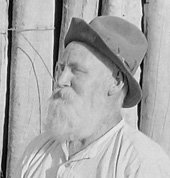




| » Images / Media | ||
| » People | ||
|
||
| » Where and when | ||
|
|
||
| » Web references | ||
|
||
| » Annotations | ||
|
 Edmund William Parke and Charlie Walker had first taken up the Henbury cattle property, they had established their station rather higher on the Finke River, at a place called Nobmintangara, about three miles south of the exit from Parke's Pass, where there were then, as at Irbmangkara, running springs in the Finke bed. A number of years later the present location had been chosen. There had also been an early outstation at Pmokoputa on the Ellery Creek, eight miles east of Hermannsburg.977Walker had built a solid one-roomed stone-house with a thatched roof here for his residence - a rare thing at the beginning of white settlement in the Centre.978This house had accidentally gone up in flames one Sunday night in April, 1880.979Pmokoputa had then ceased being used as a Henbury outstation, and the Ellery Creek block north of the Krichauff Ranges had subsequently been sublet to Hermannsburg for sheep grazing. Early in 1882 Walker, who was now living with Parke at Henbury, had gone out on a lengthy trip with Dr Charles Chewings into the country west and south-west of Hermannsburg, and had been rewarded by having three geographical features Walker's Pass, Walker Plain, and the Walker (the main tributary of the Palmer River) - named after him. Soon afterwards Walker had taken ill and gone south to seek medical aid. He had died at the Wakefield Street Private Hospital in Adelaide on 21st July, 1885, of a painful kidney and bladder complaint, aged a mere thirty one years.983His name had been kept alive in the population of the Centre by his half-caste son Charlie, whose mother had been the Henbury woman Ilkalita. |